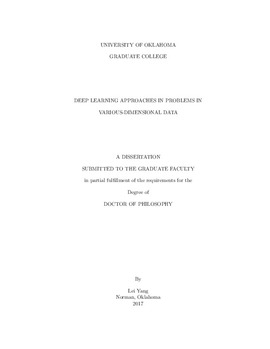| dc.contributor.advisor | Cheng, Samuel | |
| dc.contributor.author | Yang, Lei | |
| dc.date.accessioned | 2017-04-03T21:29:16Z | |
| dc.date.available | 2017-04-03T21:29:16Z | |
| dc.date.issued | 2017 | |
| dc.identifier.uri | https://hdl.handle.net/11244/50040 | |
| dc.description.abstract | This thesis develop efficient deep learning based methods for a series of tasks. I believe these problems to be inherently worth developing because of their connections to problems of practical importance. In particular, we predict the state of pain data, address the problem of visually locating two-dimensional text objects in natural scenes, and deal with LIDAR-based point cloud car detection in autonomous driving respectively.
We first addressed the pain management task. Our first novelty is converting the original collected attributes into binary features, thus avoiding the hard problem of how to represent highly-diverged attributes of collected data. We employed the discriminative RBM to directly solve the problem of feature selection and prediction simultaneously. We also observed the discriminative RBM appear to yield better accuracy than to the classical PCA and LDA with SVM classifier methods. To the best of our knowledge, our work is the first one reported to incorporate discriminate RBM (one-layer DBN) in the pain management research.
We proposed a fast text-search approach. We directly track text as an object rather than detect characters and group them together. In the processing of grouping, the majority of existing methods require a fixed-sized lexicon dictionary which reduce the generality of their models. Our approach does not need the lexicon information. Our pre-trained ConvNet automatically output the coordinates of text bounding boxes associated scores. The detections are performed in the manner of single-shot forward passing. We significantly improved the computation efficiency by a large margin. We utilize the ConvNet to represent whole scene image rather than text-only features, and encode the contextual spatial information into localization. In addition, the majority of existing text detection methods’ performance heavily rely on the complexity of image background. In contrast, the pipeline represented in this thesis does not have this limitation.
In order to detect sparse 3D point cloud, we proposed a new 3D ConvNet model by extending convolutional layer from 2D to 3D. Experiments on our collected 16-layer Lidar data demonstrates that the proposed method outperforms the regular top-down projection-based method and significantly reduce the detection time. | en_US |
| dc.language | en_US | en_US |
| dc.subject | Computer Science, Machine Learning, Deep Learning | en_US |
| dc.title | DEEP LEARNING APPROACHES IN PROBLEMS IN VARIOUS-DIMENSIONAL DATA | en_US |
| dc.contributor.committeeMember | Verma, Pramode | |
| dc.contributor.committeeMember | Ray, William | |
| dc.contributor.committeeMember | Chan, Cliff | |
| dc.contributor.committeeMember | Zheng, Bin | |
| dc.date.manuscript | 2014-04-03 | |
| dc.thesis.degree | Ph.D. | en_US |
| ou.group | College of Engineering::School of Electrical and Computer Engineering | en_US |
| shareok.nativefileaccess | restricted | en_US |
